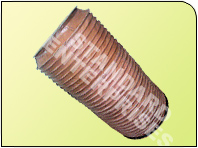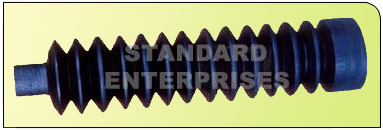Round Leather Bellows
A round leather bellows is a device used for producing a strong blast of air. It's traditionally made using flexible leather (often the primary material) and sturdy wooden handles. Bellows are commonly associated with blacksmithing and early fireplace designs. When the bellows are squeezed, the air inside is forced out, and when they are released, the air is drawn back in. The repeated action can produce a continuous stream of air.
Stitched construction are especially designed for ball screws, shafts, columns and spindles. Our Round bellows have a very stable form and stay perfectly in shape, which makes them suitable for long-term, highly demanding applications.
Our special design guarantees maintenance free operations. Round bellows joints with flange and/or sleeve are possible. Please indicate the working application position (horizontal, vertical) and the spindle diameter.
Here's a basic outline of how to make a round leather bellows
Materials
- Round pieces of leather (2)
- Wooden handles or discs (2)
- Strong thread or thin leather strips for stitching
- Valve (a one-way flap to let air in but not out)
- Adhesive (optional)
- Flexible tubing or a nozzle (optional, for directing air)
Steps
- Cutting the Leather : Start by cutting two identical round pieces of leather. The size of these pieces will determine the volume of air the bellows can push.
- Adding the Valve : You'll need a way for the bellows to draw in air. Cut a small hole in the center of one leather piece and cover it with a flap that acts as a one-way valve. This flap can be made of a smaller piece of leather or a similar flexible material. Secure it so that it allows air in when the bellows are expanded but doesn't let air out when the bellows are compressed.
- Stitching : Stitch the two round leather pieces together along their edges, leaving an opening to fit the handles or wooden discs. You want to ensure that the stitching is tight and the leather edges meet perfectly to make the bellows air-tight.
- Attaching the Handles : Insert wooden handles or discs inside the leather pocket you've created. These will be used to compress and expand the bellows. If necessary, you can glue the leather to the wooden pieces for added stability.
- Sealing : Make sure all seams and joins are sealed and airtight. You can do this using an appropriate adhesive.
- Adding a Nozzle or Tubing (Optional) : If you want to direct the air to a specific location (like a fire or a forge), attach flexible tubing or a nozzle to the open end opposite the valve.
The round leather bellows is now ready to use. By compressing and expanding the bellows, you can produce a continuous stream of air. Ensure to store the bellows in a dry place to prevent the leather from getting moldy or damaged.
Note : Leather should be treated appropriately to endure the repeated action and potential exposure to heat or fire. You might want to consider using vegetable-tanned leather or similar materials known for their durability and heat resistance.
Application industries of Round Leather Bellows
Round leather bellows are flexible, expandable devices that have been traditionally used to force air into a fire to intensify its heat. Made from leather, they can expand and contract, offering unique qualities that make them suitable for various applications. Here are several application industries for round leather bellows
- Traditional Craft & Blacksmithing : Bellows are used in traditional blacksmith forges to supply a blast of air to the fire, increasing the heat and making the forge hotter.
- Musical Instruments : Accordion and certain organ pipes use leather bellows to help produce and regulate the flow of air required to create sound.
- Industrial Machinery : In industries where machinery requires the movement of parts without the loss of an airtight seal, leather bellows are used. They ensure that no contaminants enter the machine while still allowing for parts to move.
- Photography : Traditional large format cameras often used bellows, typically not made of leather but of a similar expandable material, to allow for focus adjustments. Though not as common today, there are still niche areas in photography that use these types of cameras.
- Medical Equipment : Some medical devices, especially older ones, used leather bellows for various purposes, such as in respiration-related equipment.
- Railways : In earlier times, leather bellows were used between railway carriages to provide a flexible, yet protective, seal against the elements.
- Research & Development : Bellows can be used in laboratory settings, where there might be a need for a flexible seal in certain apparatuses or experiments.
- Aerospace & Defense : Leather bellows may be used in some niche applications where a flexible airtight seal is required in devices or machinery.
- Marine Industry : On certain older or traditional vessels, leather bellows might be found in devices used to supply air or create a vacuum.
- Automotive : Leather bellows can be used in certain vehicle parts, such as in protective covers for moving joints or in some suspension systems.
It's important to note that while leather has been the traditional material for bellows due to its durability and flexibility, modern materials like rubber, synthetic materials, or fabric-reinforced plastics have been developed and are used in many of these applications today. However, in certain niches, the unique properties and aesthetics of leather make it preferable.
Types of Round Leather Bellows
Leather bellows, often used in a variety of applications including industrial machines, musical instruments, and traditional fireplaces, utilize the flexibility of leather to create an expandable and collapsible device for producing a controlled air flow. Round leather bellows are just one design of these, and their specific types can be categorized based on their applications or features
- Fireplace Bellows : These are probably the most familiar type to most people. They are handheld devices traditionally used to blow air onto a fire to help kindle it. They typically have wooden handles and a nozzle.
- Organ Bellows : Found in traditional pipe organs, these bellows help to produce the air pressure needed to produce sound from the organ pipes. They can be quite large and are operated either manually or mechanically.
- Industrial Bellows : Used in a variety of industrial applications to provide air or to accommodate movement. They might be found in machinery or as part of ducting systems.
- Camera Bellows : While not always made of leather, bellows in cameras, especially large-format cameras, allow for flexible movement of the lens relative to the film or sensor. This provides control over focus and perspective.
- Accordion Bellows : The accordion, a musical instrument, uses bellows to draw air through reeds, producing sound.
- Compensation Bellows : These are used in machines and piping systems to compensate for thermal expansion or other movements.
- Protective Bellows : In some machinery, bellows serve as protective devices to shield moving parts, like screws or rods, from dirt, dust, or other contaminants.
Features that can differentiate types of round leather bellows include
- Number of folds or pleats : More pleats can allow for greater expansion and contraction.
- Stiffness or flexibility : Depending on the intended use, some bellows may be more rigid or more flexible.
- Size : From small handheld fireplace bellows to large industrial ones, size can vary widely.
- Materials : While we're discussing leather bellows here, it's worth noting that bellows can also be made from other materials, like fabric, rubber, or other synthetic materials, depending on the application.
When selecting or designing a leather bellow for a specific application, it's important to consider factors like the expected air pressure, the range of motion required, the environment in which it will operate (e.g., exposure to heat, chemicals, moisture), and the expected lifespan of the bellow.





